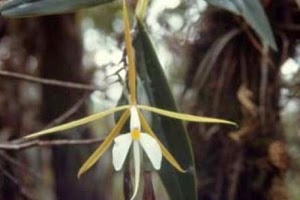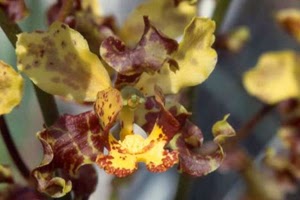|
|

|

|
|
|
|
Promoting the conservation, preservation, and restoration of the native plants and native plant communities of Broward County
|
|
|
|
|
|
|
IN THIS ISSUE
➤ September Events
➤ Feature Article: "Native Orchid Names" by Chuck McCartney
➤ Remembering long-time chapter member Barbara Jean Ansley
➤ Broward County Butterfly Chapter Has a New Home
➤ Miami Pine Rocklands Update
|
|
|
September Events
Wednesday, Sept. 9, 7pm
Secret Woods, 2701 W. State Rd. 84, Dania Beach, FL 33312
Targeting an Invasive Fern and Air Potato Biologically
Invasive plants displace native plants, so they are one of the great threats to the continued survival of our unique South Florida ecosystems. We worry, but tonight we get the facts and it is not all bad news.
Dr. Ellen Lake speaks on the "Status of ongoing biological programs targeting the invasive vines Old World climbing fern and air potato". Here is a brief summary of her background:
I first became interested in biological control as an undergraduate at Bryn Mawr College while working as a field assistant on a project on purple loosestrife. I received my master's degree and Ph.D. from the University of Delaware. My work there focused on biological control of mile-a-minute weed and integrating weed management techniques to restore invaded sites. I have been a post-doctoral research entomologist at the USDA ARS Invasive Plant Research Laboratory since the summer of 2012.
Saturday, Sept. 12, 9:00 a.m.
USDA Lab, 3225 College Ave., Fort Lauderdale, FL 33314
For GPS use: 3205 College Ave., Fort Lauderdale, FL 33314
Tour of the "Bug" Lab and Demonstration Garden
This tour is a followup to Dr. Lake's talk with a private tour of "her" lab at the mass rearing annex. The tour will include a walk through the adjacent KIND (Keep It Native Demonstration) garden with Eileen Pokorny, a chapter member who has put a great deal of effort in to creating this public garden. Meet in the parking lot of the USDA-ARS Invasive Plant Research Laboratory (behind the Agricultural Extension building) at 9:00 a.m. The tour will last 1½ or 2 hours.
Sunday, Sept. 27, 8:30-noon
Coe Visitors Center, Everglades National Park
40001 State Road 9336, Homestead, FL 33034
Hike Hole-in-the-Donut with Steve Woodmansee
Hole-in-the-Donut is a restoration area within Everglades National Park. This trip is hosted by the Dade Chapter, but they have generously extended an invitation to the Broward Chapter to join them. Steve is one of our great Florida native botanists and former FNPS president, so it is a rare opportunity to learn about species you would never otherwise see.
● Meet at Coe Visitor Center. We will leave soon after 8:30, so arrive earlier. Carpool is a good idea, especially from Broward (please arrange rides on your own).
● Entrance fee is $10 per car (unless a passenger has a national park pass). If you are late, find us near the Research Center (head toward Royal Palm, bear right to Dan Beard Center or ask directions at the Coe Center).
● Bring/wear: Wear sturdy shoes and pants that can get wet. Bring water, sun protection, bug spray (just in case), and lunch if you would like to picnic afterward.
● Difficulty: Easy to moderate
● Questions: Patty Phares (305-255-6404; cell 305-878-5705 for that morning only). There is no cell reception in the Hole-in-the-Donut area.
|
|
Native Orchid Names
By Chuck McCartney
Naming conventions
Scientific names of naturally occurring plants (and animals, too) seem to “scare” the average person when they really shouldn’t. In botany, the first part of the italicized name (the genus) is always capitalized. The second part (the species) is always lowercase (in modern usage), even when it’s derived from a proper name. Thus, the Dollar Orchid of Miami-Dade and Monroe counties is Prosthechea boothiana, even though the species is named in honor of William Beattie Booth, the grower for wealthy 19th Century English orchidist Sir Charles Lemon. (The rules for names of man-made hybrids and cultivated varieties are different.)
These seemingly strange-looking plant names are made up primarily of Latin or Greek words, with some names derived from the names of people or places.
But if you understand the meanings of these plant names, they might not be so intimidating. Here are the meanings of the scientific names for some of South Florida’s more well-known species of tropical epiphytic (tree-growing) orchids:
 |
| Epidendrum nocturnum |
Epidendrum nocturnum
The name for this largest-flowered Florida member of this genus comes from the Greek words epi (upon) and dendron (tree) and literally means “upon a tree,” referring to the fact that most of the 1,400-plus members of this New World group grow as epiphytes, using a tree as a support. The species name (epithet), nocturnum, for the Night-Scented Epidendrum comes from the Latin word for “night,” referring to the alluring incense-like nocturnal fragrance emitted by the flowers to entice their moth pollinators through the darkness.
 |
| Encyclia tampensis |
Encyclia tampensis
This most common of South Florida’s epiphytic orchids takes its genus name from the Greek words meaning “to encircle,” indicating how the side lobes of the lip (the odd petal) of the flower grow around the bloom’s central reproductive structure (called a column) in many species of this New World group. The species epithet denotes the Tampa Bay region from which the first plant of this species was sent to England, where it was described in 1847 (as an Epidendrum). This is the species often commonly called the Florida Butterfly Orchid, although, oddly, it looks nothing like a butterfly and is not pollinated by butterflies.
 |
| Prosthechea cochleata |
Prosthechea cochleata
This genus name for the Clamshell Orchid may not look familiar to longtime orchid enthusiasts because it previously was placed in Epidendrum and later Encyclia. Prosthechea comes from the Greek for an appendage or addition, referring to the appendage of tissue located on the back of the reproductive column of the flower. The species epithet comes from the Greek word for “shell” (think of marine cockleshells), referring to the upward-pointing, dark-purplish lip of the flower, which has a distinctly clamshell-like appearance.
 |
| Oncidium ensatum |
Oncidium ensatum
This species is one of the exceptions to the word “epiphytic.” Most members of this big New World genus, which now numbers approximately 317 species due to recent taxonomic realignments, are epiphytes. However, in Florida, this species is generally found growing on (not in) the ground, even though on rare occasions it has been seen growing epiphytically as well. The genus name comes from the Greek word oncos, meaning a swelling or tumor (also the source for the word “oncologist,” a doctor specializing in the treatment of tumors). For the orchids, the name refers to the callus, or swelling of tissue, near the top of the flower’s lip, which functions in the orchid’s pollination mechanism. This native of Florida, Cuba and the Bahamas has long been known as Oncidium floridanum (named for the state of Florida), but now orchid scientists believe it is the same as the Mexican/northern Central American Oncidium ensatum. That species name comes from the Latin word for a type of sword, referring to the long, sword-like leaves on the large plants of this beautiful yellow-flowered orchid.
 |
| Ionopsis utricularioides |
Ionopsis utricularioides
Both names of this pretty little Oncidium relative compare it to the flowers of other plants. The genus name comes from the Greek words ion (violet) and opsis (having the appearance or likeness of) because to German botanist Carl Sigismund Kunth, who created the genus in 1815, the flowers resembled some of the true violets in the genus Viola. (Remember that so-called African Violets in the gesneriad genus Saintpaulia are unrelated to true violets.)
Swedish botanist Olof Swartz’s 1788 species name for what he called Epidendrum utricularioides compares the flowers of this orchid to those of some species of carnivorous Bladderwort in the genus Utricularia. Worldwide, many Utricularia species do have pretty bilaterally symmetrical, orchid-like flowers. The -oides suffix on the end of the orchid’s species name is similar to -opsis in the generic name and indicates a resemblance to something else.
 |
| Cyrtopodium punctatum |
Cyrtopodium punctatum
This largest of Florida’s tropical epiphytic orchids is commonly called the Cowhorn Orchid or Cigar Orchid because of the shape of the large, elongate pseudobulbs that, when leafless in the winter, do, indeed, resemble either of those well-known objects. This New World genus takes its name from a combination of the Greek words kyrtos (curved) and podion (little foot), referring to the curved “column foot” at the back of the reproductive column that connects it to the lip. The species epithet comes from the Latin word punctatus, meaning “pricked” or “spotted,” alluding to the prominently speckled flowers of the species.
|
|
Barbara Jean Ansley
December 6, 1949 - June 8, 2015
Barbara Jean Ansley was born in Fort Myers, Florida, on December 6, 1949. She graduated from Fort Myers High School and earned a B. A. in business from Stetson University in DeLand, Florida. She was a certified public accountant and spent most of her career at Macmillan, Unruh and Davis. She retired about 15 years ago.
Barbara lived and enjoyed life to its fullest. She had many interests and talents. She traveled extensively, visiting every continent except Antarctica and almost every state.
She was a longtime member of the Fort Lauderdale Orchid Society, was president from 1986-1987, and served as treasurer for many years. She was also a member of the Broward Chapter of the Florida Native Plant Society for 20 years.
|
|
|
Broward County Butterfly Chapter
Has a New Home
The Broward County Butterfly Chapter of the North American Butterfly Association (NABA) meets Tuesday, September 15 at 6:30 p.m. at a new meeting place, Tree Tops Park in Oak Ridge Hall, 3900 S.W. 100th Ave., Davie, FL 33328. We share conservation interests with the Butterfly Chapter and a love of butterflies. Visit their web pages. The site includes a calendar of their events and much useful information:
http://www.browardbutterflies.org/wpb/
|
|
Miami Pine Rocklands Update
Two federally listed plant species may be playing a roll in protecting the Miami Pine Rocklands. You can read the latest updates and find out about upcoming public or governmental action by reading the Miami Pine Rockland Coalition blog at:
http://miamipinerocklandscoalition.org
|
|
Speaker events are on 2nd Wednesdays at 7 p.m. at the Secret Woods.
Field trips are usually on a following weekend but they vary,
so always check the Calendar and check again for last minute trip updates.
Visit Coontie.org for a wealth of information about local plants.
|
|
|
|
|
|
 |
|
|
|
|
|